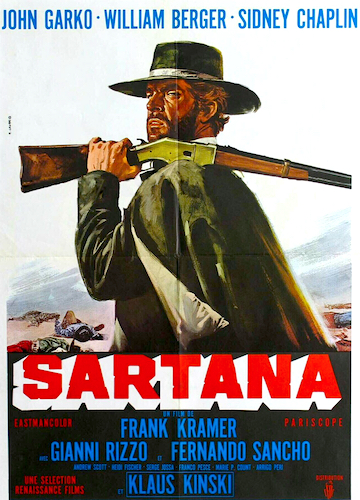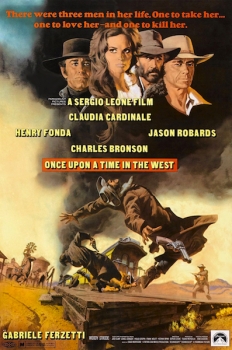
Unlike the Zatoichi films, where the English titles basically ignore the Japanese originals most of the time, the Sartana films come with English names that are pretty literal translations of the original Italian… except this one, whose original title translates as A Cloud of Dust… A Cry of Death… Sartana Arrives. Personally, I like that better — it’s more dramatic. Neither title particularly evokes the film itself, mind, which is notable as the final instalment in the official Sartana series.
The film starts very well, with the opening 20 minutes devoted to an entertaining prison break situation: Sartana (the likably cocky Gianni Garko) gets himself thrown in jail on purpose, because another inmate has (somehow) called for his help. He’s been accused of murdering his business partner to pocket the loot from a deal-gone-sour, and now everyone wants to get their mitts on that money, including the corrupt sheriff that’s locked him up. So Sartana breaks him out, sends him into hiding, and sets about investigating what really went down.
The plot seems relatively straightforward at first — it looks like it’ll be some kind of murder mystery, with Sartana cast as the detective. There are even multiple flashbacks to the night of the crime, with different accounts revealing different information for the detective to piece together — so far, so Agatha Christie. (Roberto Curti’s essay in the booklet accompanying Arrow’s Blu-ray release boldly compares it to Rashomon, but that’s a bit generous — the flashbacks don’t really offer conflicting versions of events, but piece together a timeline from characters having turned up at different times.)

A whodunit offers a nice, clear structure: you interrogate all the suspects, you work out who did it. Make the confrontations shootouts instead of verbal sparring and you’ve got a Sartana movie… right? Sadly, no — it’s not long before the story devolves into the series’ usual double-cross-athon runaround. The initial clarity gives way to another massively over-complicated and sometimes unfollowable plot involving a large cast of characters, all of whom turn out to be involved somehow and eventually wind up dead. It feels a bit rinse-and-repeat at this point.
Fortunately, the devil’s in the details — not the details of the plot, which, as I said, are baffling, but in the film itself. There are some amusing moments, like the guy who keeps claiming he’s the best shot in the West before being shown up by someone else, or a novelty wind-up cigarette lighter than Sartana finds some clever uses for. Then, for the finale, Sartana whips out his massive organ in the middle of the street to show off its hidden talents. By which I mean a church organ which, by some clever manipulation of the keys, turns out to be full of deadly tricks. The series has always had a penchant for gadgets and impossible displays of skill, but this is certainly the most cartoonish.

Arrow’s blurb for Light the Fuse says it’s “equal parts playful, violent, inventive and entertaining.” I don’t disagree those parts are present and of equal size, but their size is relatively small. They claim it “brings the series to a fine conclusion”; that it “sees Sartana sign off on a high [in] one of the best entries in the series”. I’d almost go so far as to say the opposite — it was one of my least favourite. There’s fun along the way, to be sure, but the plot borders on the meaningless and therefore becomes a tad boring. It’s not a bad film, as this series goes, but it certainly feels like a generic one.

* Credited as Anthony Ascott. ^





















 The spirit of the Spaghetti Western is kept alive in this Euro-minded South Africa-shot revenge Western.
The spirit of the Spaghetti Western is kept alive in this Euro-minded South Africa-shot revenge Western.


